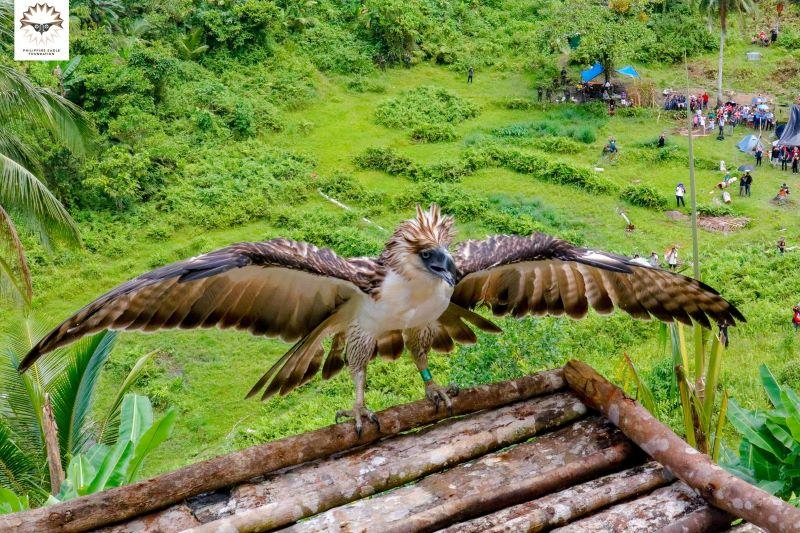EXPLAINER: Majestic but critically endangered Philippine Eagle

With its size and majestic appearance, the Philippine Eagle embodies strength in the animal kingdom, but with its population declining, protecting this predatory bird is more crucial than ever.
Endemic to the Philippines, the Philippine Eagle inhabits the forested areas of Luzon, Samar, Leyte, and Mindanao.
According to the Department of Environment and Natural Resources (DENR), the Philippine Eagle is called by different names across the country, including “Haring Ibon,” “Agila,” “Mamboogok,” “Garuda,” “Banog,” “Asinmanonoy,” and “Blok.”
Declared by then-President Fidel Ramos as the national bird in 1995, the Philippine Eagle is part of Philippine heritage, as can be seen in the cultural artifacts of several indigenous groups across the country.
It was also the official mascot during the Philippines' 2005 hosting of the Southeast Asian Games.
In 2022, the Bangko Sentral ng Pilipinas began the circulation of the new P1000 polymer banknotes, which feature the Philippine Eagle at the back.
Forest predator
Standing three feet tall, this lovely creature possesses a massive, arched beak. Its wingspan is approximately seven feet, and its head is adorned with pointed crown feathers called "crest.''
It can weigh up to 8 kilograms.
With its sharp talons that can slice through its prey, the predator bird can see eight times better than humans through its blue-gray eyes.
They hunt animals such as bats, flying squirrels, small birds, snakes, and lizards.
The raptor typically nests on forest trees and lays a single egg every two years.
Philippine Eagles can live up to 40 years in captivity, but much shorter in the wild, according to the Philippine Eagle Foundation (PEF).
Risk of extinction
The Philippine Eagle is classified as critically endangered by the International Union for Conservation of Nature, with only about 400 pairs remaining in the wild.
Deforestation and hunting of species contributed to the decline of its population.
The PEF said deforestation, upland farming, and forest encroachment destroy habitats, which causes the Philippine Eagle to go farther from their usual hunting grounds and toward human settlements and their livestock, which the bird preys on.
“The wanton use of airguns has been identified as the culprit in most rescue operations done on injured Philippine eagles,” the DENR said.
On Thursday, PEF reported that “Mangayon,” a male eagle, died from severe blood loss as it was shot on its left wing in Davao de Oro.
The PEF said Mangayon is the fourth victim of gunshots in 2024. The other eagles were “Lipadas” in Mt. Apo, “Kalatungan” in Bukidnon, and “Nariha Kabugao” in Apayao.
“This is the 20th case of eagle rescue since 2020, or a rate of 5 birds per year, which remains high,” the PEF said.
Conservation efforts
The government and non-governmental organizations work to conserve the Philippine Eagle by rescuing the raptor, rehabilitating it, and releasing it when it is well again.
Last month, two Philippine Eagles named ''Carlito'' and ''Uswag" were released in Burauen, Leyte.
Forest rangers also conduct regular nest surveys and monitoring to keep their numbers in check.
In 2023, Environment Secretary Maria Antonia Yulo Loyzaga said the agency was prioritizing two million hectares of forest land under its reforestation program.
Spreading public awareness also plays a vital role in protecting the Philippine Eagle, as it fosters compassion, concern, and respect for the raptors, the environment they are living in, and the people trying to protect them.
Loyzaga has urged lawmakers to prioritize the approval of the amendments to Republic Act 9147, or the Wildlife Resources Conservation and Protection Act.
These amendments include considering wildlife crime as a transnational offense, increasing fines and penalties for wildlife violations, expanding the role of other national government agencies and local government units in enforcing the wildlife law, and mandating government agencies to control and manage invasive alien species.
The House of Representatives passed House Bill 8586 in August 2023, while the Senate version is still pending at the committee level. —VBL, GMA Integrated News




